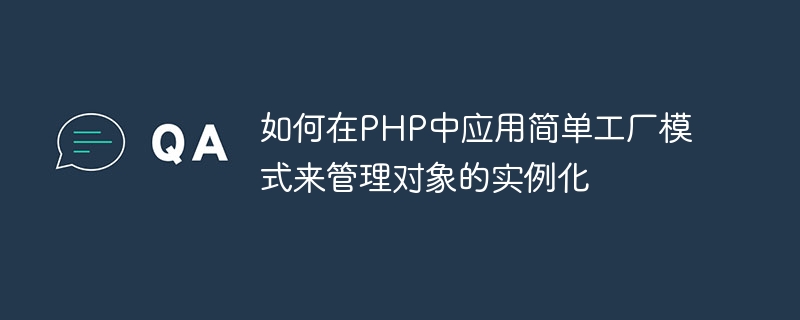

How to apply the simple factory pattern in PHP to manage the instantiation of objects
The simple factory pattern is a creational design pattern that provides a unified way to instantiate different objects to meet specific needs. In PHP, the simple factory pattern can help us better manage and organize the object creation process and improve the maintainability and scalability of the code. Next, we will explore how to apply the simple factory pattern in PHP to manage the instantiation of objects.
First, let us look at a simple example to understand the basic concept of the simple factory pattern. Suppose we have a website that displays different types of articles including news, blogs, tutorials, etc. For different types of articles, we need to create different article objects. Without using the simple factory pattern, we may instantiate different article class objects in each place for processing. This approach will lead to redundant code, and every time the code needs to be modified, every instantiation will need to be modified. By using the simple factory pattern, we can encapsulate the instantiation process of objects in factory classes and unify the process of creating and managing objects.
First, we create a base class Article, which contains public methods and properties:
abstract class Article {
protected $title;
protected $content;
// getter 和 setter 方法
public function getTitle() {
return $this->title;
}
public function setTitle($title) {
$this->title = $title;
}
public function getContent() {
return $this->content;
}
public function setContent($content){
$this->content = $content;
}
}Next, we create a specific article class, including NewsArticle, BlogArticle and TutorialArticle etc. These classes inherit from the Article class and implement their respective methods:
class NewsArticle extends Article {
public function display() {
echo "这是一篇新闻文章";
}
}
class BlogArticle extends Article {
public function display() {
echo "这是一篇博客文章";
}
}
class TutorialArticle extends Article {
public function display() {
echo "这是一篇教程文章";
}
}Next, we create a simple factory class ArticleFactory to use it according to the incoming parameters Instantiate different article objects:
class ArticleFactory {
public static function create($type) {
switch ($type) {
case 'news':
return new NewsArticle();
case 'blog':
return new BlogArticle();
case 'tutorial':
return new TutorialArticle();
default:
throw new Exception("不支持的文章类型");
}
}
}Finally, we can create different types of article objects through simple factory classes:
$news = ArticleFactory::create('news');
$news->setTitle('PHP简单工厂模式应用示例');
$news->setContent('简单工厂模式是一种创建型设计模式...');
$blog = ArticleFactory::create('blog');
$blog->setTitle('学习PHP简单工厂模式');
$blog->setContent('简单工厂模式是一种创建型设计模式...');
$tutorial = ArticleFactory::create('tutorial');
$tutorial->setTitle('使用PHP简单工厂模式');
$tutorial->setContent('简单工厂模式是一种创建型设计模式...');
$news->display(); // 输出:这是一篇新闻文章
$blog->display(); // 输出:这是一篇博客文章
$tutorial->display(); // 输出:这是一篇教程文章Through the above examples, we can see that in simple application After the factory pattern, we only need to use the factory class to create objects, without directly instantiating specific article classes. In this way, when we need to add a new article type, we only need to add a corresponding case in the factory class without modifying other code. This greatly improves the maintainability and scalability of the code.
The simple factory pattern is a simple and practical design pattern. Applying the simple factory pattern in PHP can make the code clearer and more flexible. Moreover, the simple factory pattern also conforms to the single responsibility principle, separating object creation and business logic, improving the readability of the code. When faced with scenarios where different objects need to be instantiated according to different conditions, the simple factory pattern is a very good solution.
The above is the detailed content of How to apply the simple factory pattern in PHP to manage the instantiation of objects. For more information, please follow other related articles on the PHP Chinese website!




